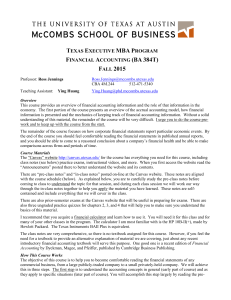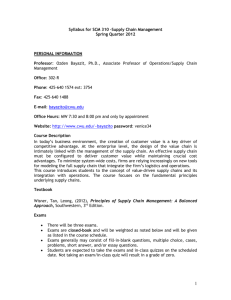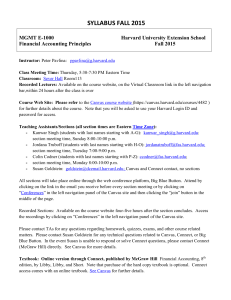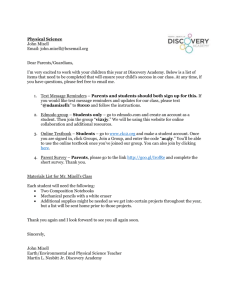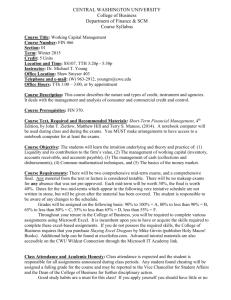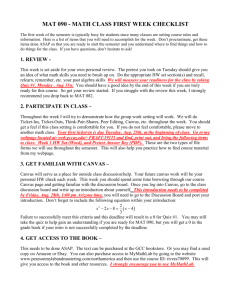Financial Accounting (TEMBA) - Jennings
advertisement
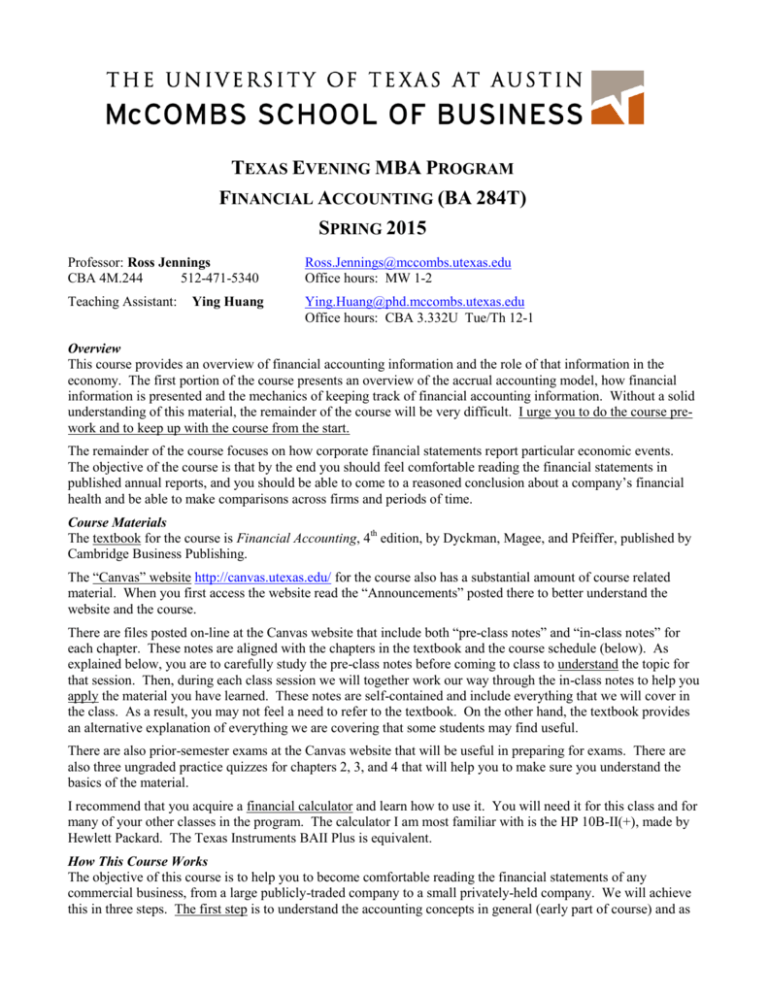
TEXAS EVENING MBA PROGRAM FINANCIAL ACCOUNTING (BA 284T) SPRING 2015 Professor: Ross Jennings CBA 4M.244 512-471-5340 Ross.Jennings@mccombs.utexas.edu Office hours: MW 1-2 Teaching Assistant: Ying.Huang@phd.mccombs.utexas.edu Office hours: CBA 3.332U Tue/Th 12-1 Ying Huang Overview This course provides an overview of financial accounting information and the role of that information in the economy. The first portion of the course presents an overview of the accrual accounting model, how financial information is presented and the mechanics of keeping track of financial accounting information. Without a solid understanding of this material, the remainder of the course will be very difficult. I urge you to do the course prework and to keep up with the course from the start. The remainder of the course focuses on how corporate financial statements report particular economic events. The objective of the course is that by the end you should feel comfortable reading the financial statements in published annual reports, and you should be able to come to a reasoned conclusion about a company’s financial health and be able to make comparisons across firms and periods of time. Course Materials The textbook for the course is Financial Accounting, 4th edition, by Dyckman, Magee, and Pfeiffer, published by Cambridge Business Publishing. The “Canvas” website http://canvas.utexas.edu/ for the course also has a substantial amount of course related material. When you first access the website read the “Announcements” posted there to better understand the website and the course. There are files posted on-line at the Canvas website that include both “pre-class notes” and “in-class notes” for each chapter. These notes are aligned with the chapters in the textbook and the course schedule (below). As explained below, you are to carefully study the pre-class notes before coming to class to understand the topic for that session. Then, during each class session we will together work our way through the in-class notes to help you apply the material you have learned. These notes are self-contained and include everything that we will cover in the class. As a result, you may not feel a need to refer to the textbook. On the other hand, the textbook provides an alternative explanation of everything we are covering that some students may find useful. There are also prior-semester exams at the Canvas website that will be useful in preparing for exams. There are also three ungraded practice quizzes for chapters 2, 3, and 4 that will help you to make sure you understand the basics of the material. I recommend that you acquire a financial calculator and learn how to use it. You will need it for this class and for many of your other classes in the program. The calculator I am most familiar with is the HP 10B-II(+), made by Hewlett Packard. The Texas Instruments BAII Plus is equivalent. How This Course Works The objective of this course is to help you to become comfortable reading the financial statements of any commercial business, from a large publicly-traded company to a small privately-held company. We will achieve this in three steps. The first step is to understand the accounting concepts in general (early part of course) and as Ross Jennings Financial Accounting – Evening MBA Program, Spring 2015 page 2 they apply to specific situations (later part of course). You will accomplish this step largely by reading the preclass notes, using the textbook as a resource to understand those notes where needed, and by completing your assigned homework. The second step is to apply these accounting concepts to actual financial statements. This step will be the focus of our in-class work. You will get the most out of our time in class if you have studied the relevant accounting concepts before you come to class. The third step is practice. I can’t emphasize this enough. Learning accounting requires practice. The more you practice the more comfortable you will become with financial statements and the better you will do in the course. I hear this over and over from students and I have seen it in class year after year. Likely you are no different. The way to practice is to review all of the problems we do in class, do all of the old exam problems that I provide to you, apply these old problems to other sets of financial statements and solve those, all the while discussing all of this in your groups. Groups are great, use them. My only word of caution is that in the end you will take the exams by yourself, so make sure before each exam that you can succeed independent of the group. Class Sessions As you will quickly see, I like class to be very interactive. I hope you will come prepared and that you will ask questions when you don’t understand something and that you will bring up examples from your work when they are relevant, this greatly enriches the class discussion. The more you engage the more interesting class will be, the more you will get out of each class session, and the easier the course will be. Grades Grades for the course will be assigned to conform to the following general guidelines that apply to all courses in the program: about 25% A, about 20% A-, about 15% B+, about 35% B, and about 5% B- and below. Grades of C and below will be given to those who have earned them. These are guidelines, not fixed rules. Final grades will be determined on the basis of the following assignments and weights. Grading Summary Points Percent Homework 100 20% Quizzes – 75 points each 150 30% Final Project 50 10% Final Exam 200 40% Total 500 100% To determine final grades I rank all of the students in the class from highest to lowest on the basis of total points. I then draw lines between A and A- and between A- and B+, etc., based on the guidelines described above. Homework For each class session (except the first and last) you will have homework due before class. These problems are all from the pre-class notes for that session and are clearly indicated in the notes. The homework will be graded mostly for completeness, and I expect that all students will receive full credit for the homework. The homework will be turned in at the Canvas website, and instructions for how to do so are posted at Canvas. Exams During the semester we will have two quizzes and a final exam that are closed book and closed notes. You may bring a calculator to the exams, but it should not have emailing or text features. Each quiz or exam will be based on the actual financial statements of a real company. You will be told in advance which company and which fiscal year will be used so that you may specifically study these financial statements before the exam. Final Project The final project consists of computing a small number of ratios for a company of your choice and writing a short narrative that describes what you found. Details are provided after the course schedule below. Honor Code Collaboration is strongly encouraged outside of class. However, homework must be completed independently, and the sharing of electronic files for homework or the final project and collaboration on exams is not permitted. Disabilities The University provides upon request appropriate academic accommodations for qualified students with disabilities. For information, contact the Office of the Dean of Students at 471-6259, 471-4641 TTY. Ross Jennings Financial Accounting – Evening MBA Program, Spring 2015 page 3 Advice for Success Many of you are new to accounting, have been out of school for a while, will find the course materials confusing, and will find the pace of the course to be fast. You are all busy and each of you needs to find a rhythm to your studies for this course that is most efficient for you. That rhythm may not be the same for everyone, but here are some recommendations to get you started. You can modify from here to suit your own needs. Most Important Chapters 1-4 are the most important in the course and the foundation for all that follows. As a result it is especially important that you follow the advice below for these four chapters. In addition, at Canvas you will find three (ungraded) multiple choice quizzes that are focused on the material in chapters 2, 3, and 4. These quizzes can be very useful in helping you to master this material. Weekly Before each class session you should study the pre-class notes for that session and complete the homework. The homework will be graded on a completion basis, so it is possible to just skim the material, guess at something for the homework and get full credit. This is a really bad idea. You should read through the notes slowly and thoughtfully, doing each of the example exercises and thinking about why the answer is the right answer. Then slowly do the homework and think about what you are doing. Review the in-class notes and financial statements before you come to class. This is not required, but highly recommended. The more prepared you are for each class session the more you will get out of that class session. If you come to class knowing where your weaknesses or questions are, there is a better chance they will be asked and answered in class. Come to class and engage—don’t multi-task. Class time is an important time to fill in the gaps in your knowledge that you identified in your pre-class preparation. This is best done by paying attention and asking questions about whatever is not clear. Review the in-class notes after class. Sometimes when you watch me in class you think you understand something, but once out of class you can’t remember exactly what you thought you knew. A quick review the next day, using the annotated notes with solutions provided at Canvas, will help you to identify something you might not completely understand so that you can go back over the notes, or consult with a classmate, or send me an e-mail. Prior to Quizzes and Exams Review the in-class notes one more time. By now you have been through these notes three previous times, so you should be quite sure of what you understand well and what you are not so sure about. For remaining questions, consult with a classmate or send me an e-mail. Review prior exams. Spend fifteen or twenty minutes familiarizing yourself with the financial statements attached to the prior exam first, and then begin to attempt the problems. Give the problems a good try before looking at the solution, but do not spend too much time trying to figure out an answer that you are unsure of. If, after you look at the solution, you are still not sure why that is the correct answer, consult with a classmate or send me an e-mail. Save one prior exam to take under test-like conditions. As you use the prior exams to study, it is easy to use the solution as a crutch and as a result overestimate what you understand. Taking one of the exams under test-like conditions and then grading it objectively will give you a better sense of what you understand and what you do not understand. Study the financial statements for the quiz or exam. It is essential that you understand the financial statements and notes that will be the basis for your exam or quiz prior to coming to the quiz. If there is something you don’t understand consult with a classmate or send me an e-mail. Make up exam problems using the financial statements for the quiz or exam and solve them. This is a great way to both become familiar with the financial statements and anticipate what will be on the quiz or exam. This is also a great activity to do with a study group. Course Schedule – The Texas Evening MBA Program Date Chapter Topic Jan 05 1/2 Introducing Financial Statements and Constructing Financial Statements No homework due Jan 12 3/4 Adjusting Accounts for Financial Statements and Reporting and Analyzing Cash Flows HW: See Pre-Class Notes for Chapter 3 Jan 21 4 Quiz on Chapters 1-3 and Adjusting Accounts for Financial Statements and HW: See Pre-Class Notes for Chapter 4 Jan 26 6a/6b Reporting and Analyzing Revenue and Receivables HW: See Pre-Class Notes for Chapters 6a and 6b Feb 02 7 Quiz on Chapters 1-6 and Reporting and Analyzing Inventory HW: See Pre-Class Notes for Chapter 7 Feb 09 8a/8b Reporting and Analyzing Long-Term (Tangible) Operating Assets HW: See Pre-Class Notes for Chapters 8a and 8b Feb 16 9/10 Reporting and Analyzing Liabilities and Reporting and Analyzing Leases HW: See Pre-Class Notes for Chapters 9 and 10 Feb 23 FINAL EXAM -5- TEXAS EVENING MBA PROGRAM FINAL PROJECT FINANCIAL ACCOUNTING (BA 284T) SPRING 2015 Your “final project” is a financial statement analysis of a company you select. The ratios you are asked to compute are discussed in the class notes and the textbook. Your completed project should include: A completed table of ratios and other financial statement measures for the company you select. This table is shown at the bottom of the next page. A brief (1-2 page single spaced) evaluation of your company’s financial ratios, comprising the following four sections: Section I—A brief (1-3 sentences) summary of your company’s business and the economic environment in which it operates. Section II — A brief evaluation over time of your company’s: - Return on equity (ROE), - DuPont ratio components (profitability, efficiency and leverage), and - LT Debt-to-Assets ratio Section III —A brief evaluation over time of your company’s: - Cash conversion cycle - Cash liquidity and Cash Sources & Uses Section IV — A brief (e.g., 1-2 sentence) description of the overall ratio trend and what it implies for current and future financial performance. Each section should have an appropriate heading and the writing should be in the form of sentences and paragraphs, not bullet points. You may confer with colleagues and any other resources, including me or the TAs, in thinking about your company financial statement analysis. However, you must individually draft your response to this assignment. The emphasis is on effort, not results—full credit is awarded for a good faith effort to complete this assignment. You will probably be able to find all of the financial statement information you need at the company’s website. Note, that you will have to look at more than one annual report to get enough years of data to do all of the computations. If you have trouble finding the information you can pick another company Company selection. By midnight on Wednesday, January 21st, you should submit via Canvas the name of the company you have selected to analyze. To do this use the “Discussion Board” link at Canvas entitled “DISCUSSION BOARD, Select Your Company” and follow the directions. Each member of the class must select a different company. Company selection is on a first-come first-serve basis as established by your posting to the discussion board. Please review the discussion board to confirm that the company you wish to select has not -6already been selected. Please ensure that the company has data for all of the ratios below. This especially means that the company has (a) accounts receivable, (b) inventory, and (c) accounts payable. This will eliminate companies in certain industries such as financial services. Company analysis deadline. Your company analysis is due by midnight on Thursday, February 26th. I strongly encourage you to chip away at the assignment during the semester, and you will find that completing it at the end of the semester prior to the final exam is not difficult. I welcome you to submit the assignment before the deadline if you have completed it early. You should submit the assignment directly to Canvas, similar to the way in which you submit homework. It is not necessary to turn in copies of the company’s financial statements or the spreadsheet you used to compute your ratios. Copy this table into your report and complete the ratios for the three most recent years for which you have data. FINANCIAL STATEMENT ANAYLYSIS -- YOUR COMPANY Company name: Company ticker: Your name (cohort): Ratios and Other Analysis Measures ROE and DuPont Ratios ROE (NI / OEavg) Profitability (NI / Sales) Efficiency (Turnover = Sales / Assets avg) Leverage (Leverage = Assets avg / OEavg) Additional Efficiency Ratios AR Turnover (Sales / ARavg) Days Receivables Outstanding (DRO) [ARavg / (Sales/365)] Inventory Turnover (COGS / Inventoryavg) Days Inventory (DI) [Inventoryavg / (COGS/365)] AP Turnover (Purchases / AP avg) Days Payables Outstanding (DPO) [365 / (Purchases / Accts Payableavg)] CASH CONVERSION CYCLE (DI - DPO + DRO) Additional Leverage Ratio LT Debt-to-Assets (LT Debt, including current portion / total Assets) Cash Liquidity and Cash Sources & Uses Working Capital (CA - CL) Current Ratio (CA / CL) Quick Ratio [(Cash + ST Securities + AR) / CL)] Year End (3 years)
